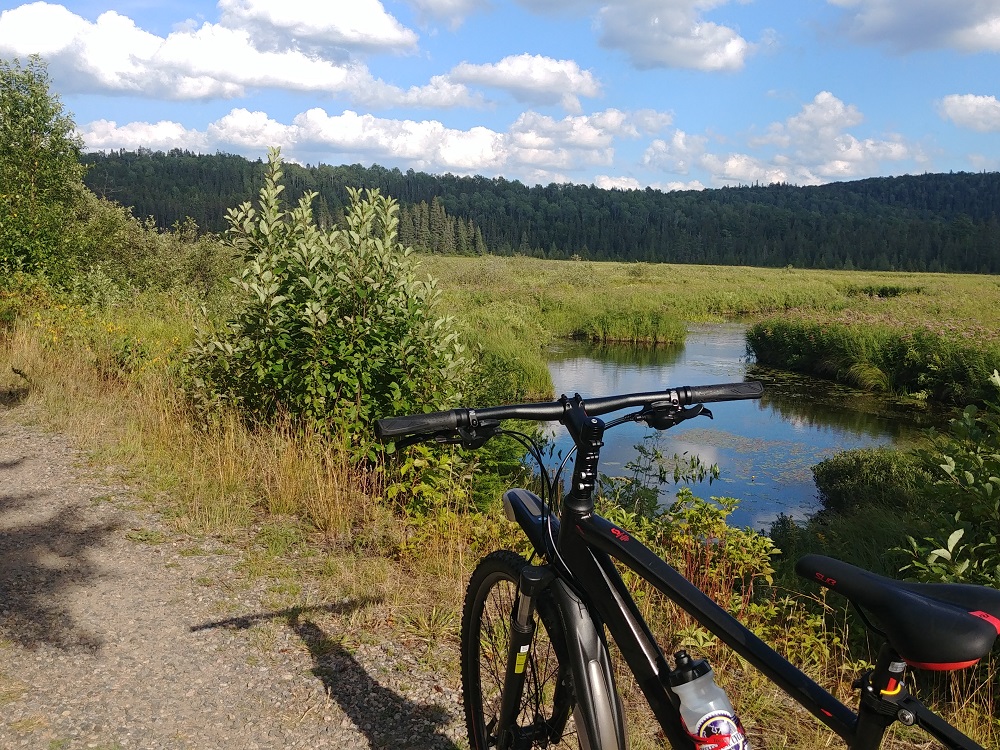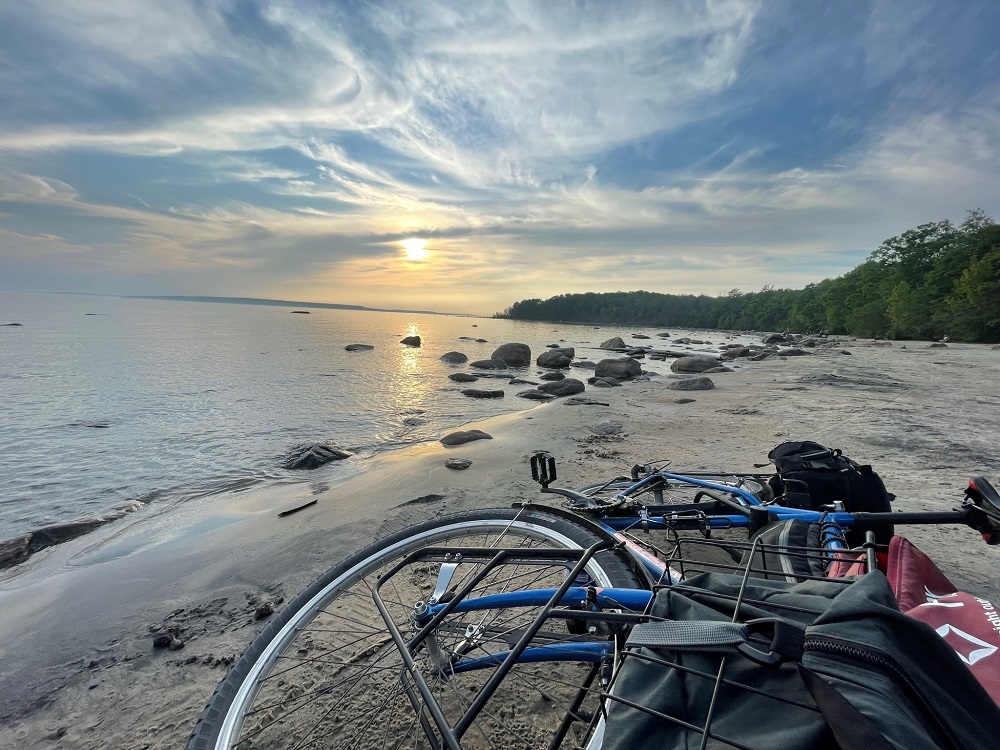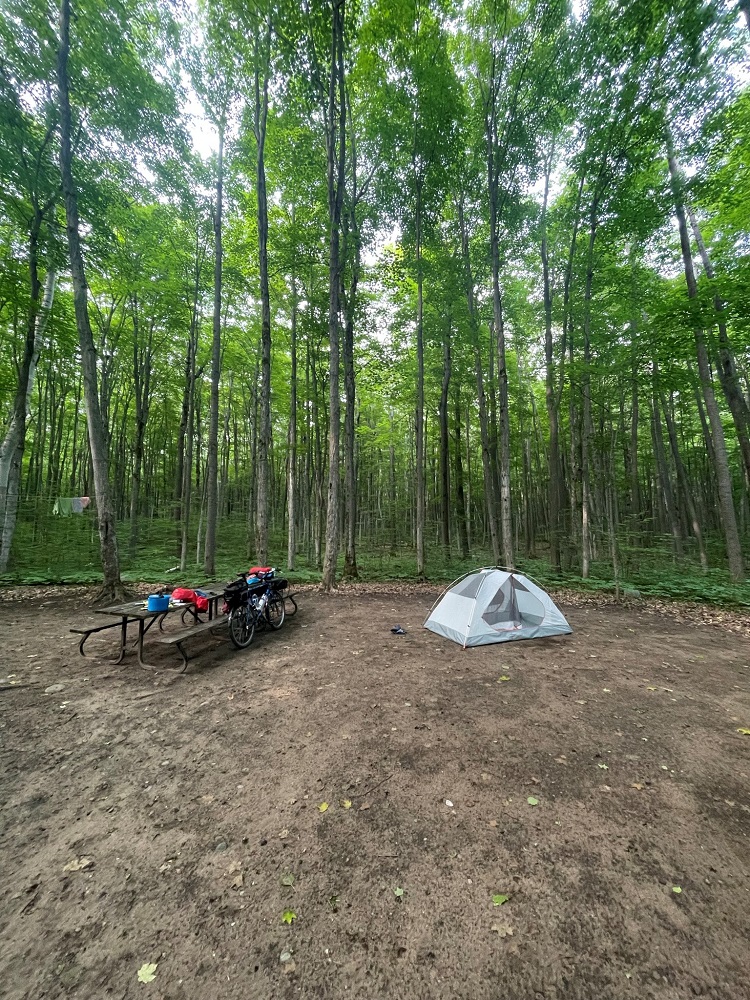At Ontario Parks, we’re constantly on the lookout for ways to promote both the health and wellbeing of our visitors and the parks we protect.
The importance of spending time in nature is well documented in scientific research, and we embody our efforts to promote spending more time in nature through our Healthy Parks Healthy People movement.
Provincial parks are great places to get your nature fix – but have you ever thought about incorporating time in nature into the way you get to your favourite park?
Introducing bikepacking!
Also commonly known as bike touring, bikepacking is by no means a new phenomenon. There’s a long history of travelling by bicycle embedded in our collective cultural fabrics around the globe.
While it may seem complicated, the concept in reality is quite simple – next time you visit a park, consider riding your bike to get there!
Whether you’re visiting for the day or overnight, your bike is an excellent tool to get you where you want to go. Not only is it one of the most efficient tools for human-powered travel, it’s environmentally friendly, healthy, and fun!
Ontario has a growing community of “bikepackers” and we’re jumping on board the trend.
To help you experience life on two wheels, we’ve collected some information to make your next visit by bike roll smoothly.
What you’ll need
A bike! That’s pretty much it.
Seriously, one of the best things about bikepacking is that all you’ll need to get started is a bike in good working order.
While there are certain traits in a bike that bikepackers appreciate, almost any bike will work for a bikepacking trip at a fundamental level.

There’s an ethos in the bikepacking community that captures this simplicity: “Run what you brung,” meaning you should use equipment already available to you.
Travelling by bike is meant to be uncomplicated, cost-effective, and relaxing.
For those planning an overnight bikepacking trip, your existing camping equipment is likely sufficient. Backpackers and canoe campers, you’re likely good to go with your existing camping equipment.
One of the best parts about bikepacking? Your bike does all of the heavy lifting!
There are countless ways to load your bike with all the gear you’ll need (and then some) for your bikepacking trips.
This includes anything from special racks and bags designed specifically for bikes, as well as DIY solutions for transporting your equipment by bike. The internet is full of ideas for both, so take some time exploring your options.
Over time, you’ll develop preferences that work best for your bikepacking style.
Planning your trip
Once your equipment is ready, it’s time to plan your first trip.
Generally, it’s recommended to choose a nearby destination from your home to use as a “shakedown” ride, allowing you to test your bike and equipment on a shorter trip before embarking to further destinations.
When planning your first ride, consider a route that has a lot of options like nearby public transit or multiple locations to camp at various points along your route in case you become delayed.
Other considerations include the actual route you’ll take, and whether you’ll be spending time on roads or trails.
For many, avoiding roads (especially busy ones) is a strong preference when route planning.
In Ontario (especially southern Ontario), we’re spoiled with numerous trails that lead to various parts of the province, many near provincial parks.
To plan a route, there are many existing resources on the internet that will guide your planning.
There are dedicated websites for bikepacking that have articles about planning your first trips, as well as mapping resources like Google Maps that have specific layers for cycling infrastructure.
When planning your route, it may be helpful to consider the information available from trail organizations like the Great Lakes Waterfront Trail and the TransCanada Trail to see which parks are near these established routes.
All things considered, the most important part of visiting parks by bike is to stay safe. A key factor in safety is planning trips that are within your limitations.
By keeping trips manageable, you’ll ensure that your next park visit by bike is a relaxing, enjoyable, and healthy way to spend time in nature.
Once you arrive at the park, remember to properly store your food, especially if you’re camping in bear country. We recommend contacting your destination(s) ahead of time to see if food storage lockers are available or if food supplies are available for purchase. Alternatively, learn how to properly hang a food bag.
Route inspiration
Here are some bikepacking ideas to get you started.
Whichever destination you choose, please thoroughly research your plans before embarking on your visit. These routes are for cursory informational purposes only.
Everyone’s situation is different. From comfort, capability, and experience, make sure the routes you take are right for you.
Route 1: Toronto to Darlington Provincial Park
For those in the GTA, take this excellent shakedown ride following the Great Lakes Waterfront Trail from Toronto to Darlington.
Located near the city of Oshawa, Darlington is a great destination for new and experienced bikepackers alike due to the well-travelled, established route along Lake Ontario, the opportunity to easily find food and other supplies along the route, and the ability to use GO Transit’s Lakeshore East train line to customize your route distance and difficulty.
The trail from Toronto to Darlington is quite scenic, with frequent views of Lake Ontario. You’ll also pass by distinct environments like the Scarborough Bluffs and Rouge National Urban Park as you wind your way along the trail.
Since the trail runs right through downtown Toronto, it’s accessible both by other trails and public transit from many surrounding communities.
Route 2: Barrie to Awenda Provincial Park (and beyond!)
Travel from Barrie to Awenda via the Simcoe County Loop Trail.
The approximately 75 km section from Barrie to Penatanguishene (near Awenda) is primarily along an old railway corridor that was converted into a multi-use trail.
This means that the trail is very level with few elevation changes, and the riding surface is well packed and smooth.
The route is mostly car free, other than a short section from Barrie to the trailhead and from Penatanguishene to Awenda.
Overnight parking can be found in Barrie and riders along the GO Transit network can consider taking a GO train or bus to downtown Barrie to begin the ride.
Those looking for a larger adventure should consider the rest of the Simcoe County Loop Trail, which continues on east from Penatanguishene to Coldwater, then south through Orillia.
Stops at Bass Lake Provincial Park, Mara Provincial Park, and McRae Provincial Park make this a weekend-worthy bikepacking experience that’s nearby and natural!
Build your own trip to parks along Lake Huron and Lake Erie
The shores of Lake Huron and Lake Erie offer excellent bikepacking potential!
There are countless provincial parks locations along the shores of these lakes that are connected by the Great Lakes Waterfront Trail.
On the Lake Huron side, most provincial parks are located approximately 40 to 100 kilometers apart, allowing visitors to fully customize the length of travel required per day to best suit the experience they’re looking for.
Examples of Lake Huron provincial parks to consider include:
- Sauble Falls Provincial Park
- MacGregor Point Provincial Park
- Inverhuron Provincial Park
- Point Farms Provincial Park
- Pinery Provincial Park
On the shores of Lake Erie, provincial park options include:
- Wheatley Provincial Park
- Rondeau Provincial Park
- Port Burwell Provincial Park
- Long Point Provincial Park
- Turkey Point Provincial Park
- Selkirk Provincial Park
- Rock Point Provincial Park
Next time you plan a visit to Ontario Parks, consider leaving the car at home and make your next trip on two wheels!







